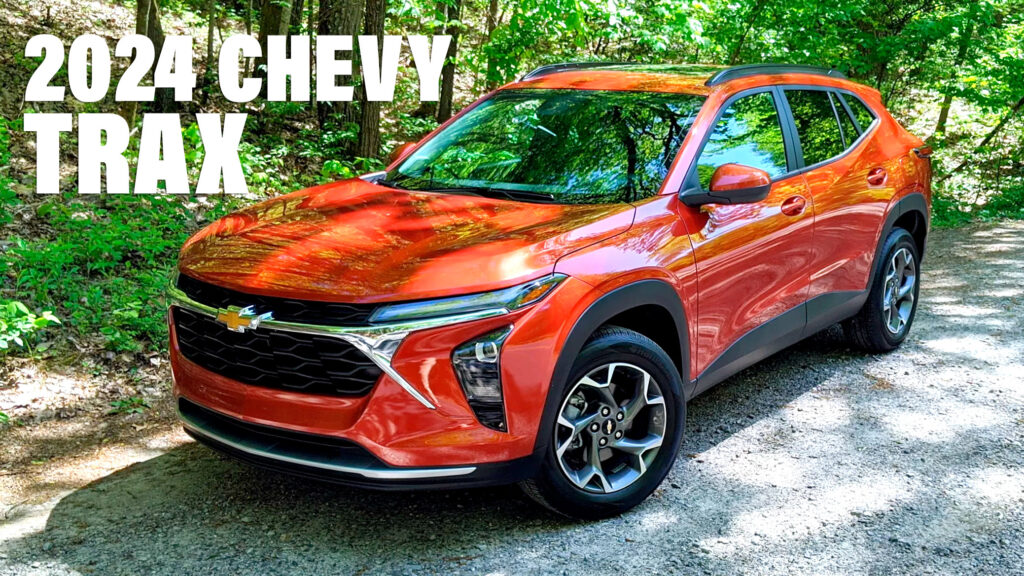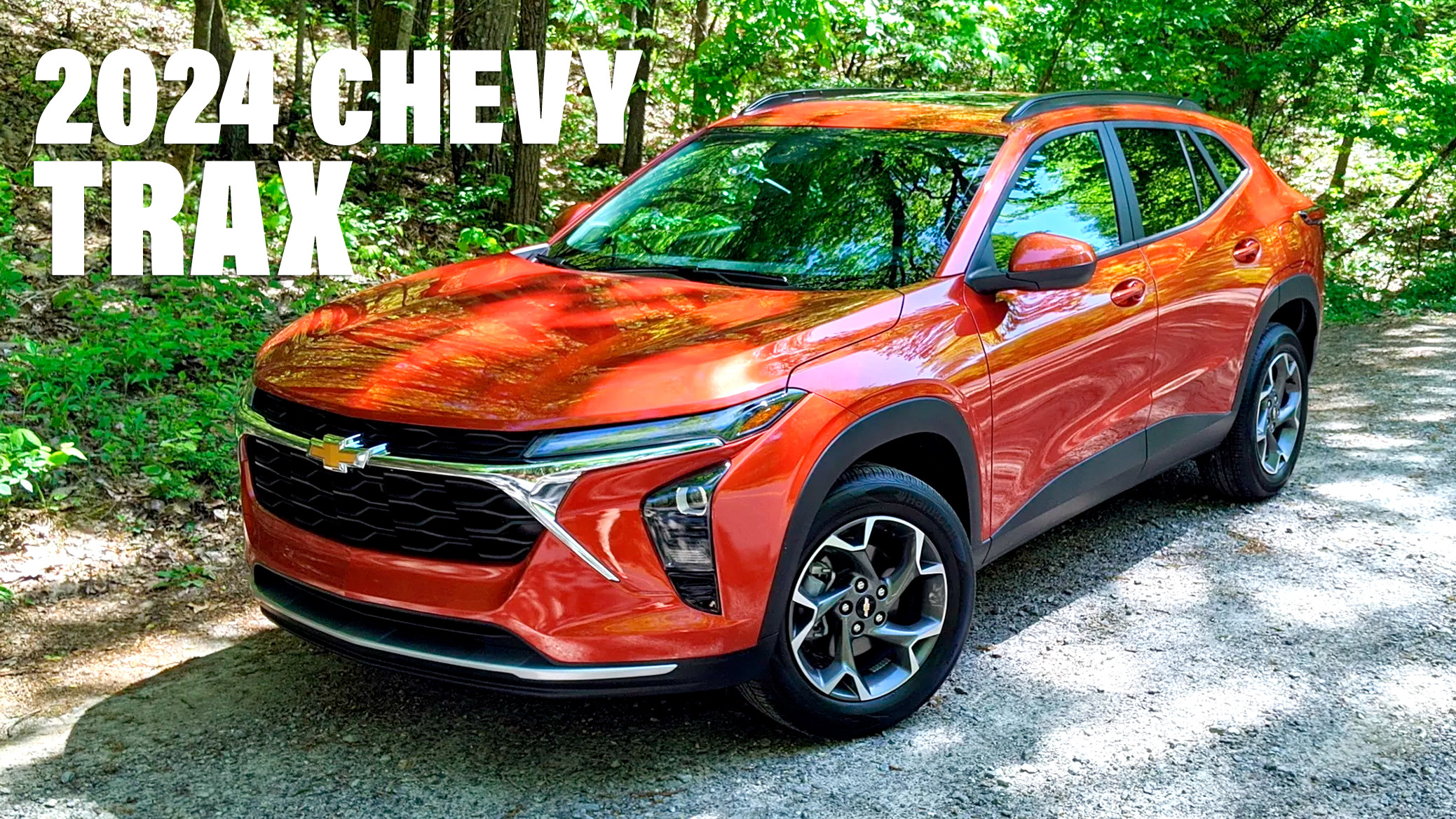Starting under $22,000, Chevy’s entry-level model may have less power than before, but it costs less and boasts an attractive design and improved interior
May 2, 2023 at 09:00

by Stephen Rivers
Chevrolet’s all-new 2024 Trax sets a new low bar in the best way that one can. We didn’t go into our testing of this new small crossover thinking that less horsepower than last year’s model and the absence of all-wheel drive would end up very good. We were wrong but not for the reasons we expected.
Globally Improved
The 2024 Chevy Trax isn’t just all-new for the USA. It’s new across several markets around the globe. Well, mostly new. It debuted in mid-2022 as an all-new model in China called the Seeker. As such, it looks almost identical to that vehicle which is to say that it leans into the rest of Chevy’s current design language pretty hard.
If you mistake it for a Trailblazer or even the normal Blazer after a quick glance we wouldn’t blame you. That’s very intentional. The face of this crossover is no longer a downmarket droopy one. It’s sharp, it’s angular, and it leans into the trend of high-mounted LED daytime running lights, and low-mounted minimalist headlights.
The new look isn’t one Chevy can afford to miss on. The Trax now sits at the bottom of the lineup as the entry-level offering now that the Spark, Sonic, and Cruze are long gone. While there’s no wild wow factor to speak of on this umteenth crossover, we think it looks dramatically better than the outgoing generation.
| Quick Facts | |
|---|---|
| › Model: | 2024 Chevrolet Trax |
| › Starting MSRP: | $21,495 |
| › Dimensions: | 178.6 (4,537mm) L x 71.7 (1,823mm) W x 61.4 (1,560mm) H |
| › Engine: | 1.2-Liter Turbocharged Three-Cylinder |
| › Output: | 137 hp (102 kW) 162 lb-ft (219 Nm |
| › Transmission: | Six-Speed Automatic |
| › Fuel Economy | City 28 – Highway 32 – Combined 30 EPA-EST |
| › On Sale: | Now |
Under the bodywork, things don’t sound like an improvement on paper. Front-wheel drive is the only option as is a 1.2-liter (yes, you read that right) three-cylinder turbocharged engine that makes just 137 hp (102 kW) and 162 lb-ft (219 Nm) of torque. It transmits power to the wheels through a six-speed automatic gearbox. That meager power amount is 18 hp (13 kW) and 15 lb-ft (20 Nm) less than the old Trax but Chevy promises that this one is faster.
advertisement scroll to continue
Chevrolet said that the entire package is such a dramatic shift from the old car that they considered renaming this car to something altogether different. It stuck with “Trax” simply because it already had recognition among customers.
A Sharp New Interior
Photos Stephen Rivers/Carscoops
If there’s a somewhat obvious and glaring flaw in a lot of GM products is the existence of cheap plastics and terrible switchgear. The Trax certainly doesn’t end that complaint altogether but it hides those downfalls underneath a layer of sharp design that we really like.
Keeping in mind that much of aesthetic design is subjective, the inside of the Trax is really attractive. In fact, after driving the GMC Canyon Denali and AT4X just before the Trax, we prefer some details in the crossover. Here’s why.
Take a quick look at that dash again. Notice the asymmetrical angles that point more at the driver than the passenger. That’s a nice touch and in our eyes looks better than the ones you’ll find in the aforementioned Blazer siblings. Look a little closer and you’ll also notice small touches like patterning in the plastics on the dash.
Photos Stephen Rivers/Carscoops
That theme of adding a bit of detail where Chevy could’ve skipped it continues throughout the cabin. The climate vents get little colored fins, the door cards get more texturing, and the seats have unique patterns too. These are the kinds of things that have been lacking across many GM products. We’re impressed to see them on the brand’s new entry-level model.
The base Trax comes with an 8-inch infotainment system and a 3.5-inch driver information display flanked by two analog gauges. The top three trim levels all get an 8-inch fully-digital gauge cluster and an 11-inch touchscreen infotainment system. For a deeper dive into what content comes on what trim level see our breakdown here.
It’s also worth noting that the Trax is considerably larger than the old model. In fact, it’s 11 inches (279 mm) longer, 4 inches lower (101 mm), and 2 inches (51 mm) wider than it was in the past. That translates to more cargo and passenger capacity including three extra inches of legroom in the back seat and up to 25.6 cubic feet of storage behind the seats.
Regardless of trim level or options, every Trax is mechanically the same aside from differences in the wheel and or tire combination.
Adequate Ride Quality
Photos Stephen Rivers/Carscoops
Chevrolet told us that its Trax customers want a vehicle that still drives much like a car and for the most part, they’ve delivered that. Our testing grounds were a mix of urban streets around Asheville proper and remote locations like Bat Cave, NC, and Chimney Rock State Park. Neither of which featured a place to take a photo of the Trax with the attraction in the background sadly. The mix of roads did serve to prove that the Trax is a jack of all trades and a master of none.
In town, the little three-cylinder engine is adequate. In fact, we doubt most folks wouldn’t know that they were propelled by such a pint-sized engine. Low-end torque is readily available and the six-speed automatic is smooth. It’s quiet too thanks to active noise cancellation on every trim level. The seats are comfortable, moderately adjustable, and supportive enough that long drives don’t feel taxing.
When we got out of the city and onto winding Highway 74 southeast of Asheville the Trax’s handling was sincerely good. The steering wheel has a decent bit of numbness on center but on twisty roads, it communicates well and it’s surprisingly easy to place. Even when pushed hard it fights off understeer admirably.
It’s not a perfect package mind you. Modulating the throttle is a chore when driving aggressively. About 70 percent of the pedal seems to provide about 20 percent of the available power. When you reach above that input threshold there’s a noticeable delay before finally the Trax gears down, spools up a bit of boost, and gives you what power it can.
There’s a big fuel economy penalty for trying such driving too. In our testing, we achieved just 18.7 mpg combined over about 60 miles. Still, this little crossover isn’t meant to set anybody’s hair on fire. It’s a commuter, and it’s good at that.
In Conclusion: Bulking Up For A Fight
Just like every other SUV segment, the small crossover is filling up fast and the Trax has its work cut out for it. Chevrolet directly compared the Hyundai Venue and the Nissan Kicks. Those two crossovers also feature front-wheel drive only and similar pricing brackets. They’re also less powerful and, at least in our opinion, don’t look anywhere near as good.
Practicality is the name of the game in this segment though and while the Trax might look great, Chevrolet at 3 years or 36,000 miles bumper to bumper doesn’t come anywhere near Hyundai in terms of warranty coverage (5y/60k miles) or complimentary maintenance. Don’t forget either that the base Mazda CX-30 is available for what a top-of-the-line Trax will cost. Of course, the Trailblazer also overlaps it in terms of pricing but to us doesn’t offer anywhere near as much as a CX-30 or even a low-end Hyundai Kona.
For buyers shopping in this small SUV segment, the Trax is absolutely worthy of consideration. With an attractive starting price of $20,400 before a $1,095 destination fee for a total of $21,495, which is $1,400 less than the outgoing model, it’s not a perfect car but it feels like a sincerely big step forward for Chevrolet. The new entry-level Bowtie bearer sets a new standard that we hope to see translate to all future models in the family.

where to buy stromectol – carbamazepine pill tegretol cost
purchase isotretinoin pill – accutane ca linezolid brand
azithromycin 250mg canada – oral azithromycin bystolic cheap
buy omnacortil without a prescription – prometrium 100mg pill buy prometrium without a prescription
buy furosemide 100mg without prescription – buy lasix 100mg online cheap purchase betamethasone without prescription
augmentin 1000mg for sale – buy augmentin 375mg buy duloxetine generic
pfizer viagra 50mg – viagra 100mg drug order tadalafil 20mg sale
buy tadalafil tablets – sildenafil 50mg tablet cost sildenafil
buy generic cenforce for sale – oral metformin 500mg buy glycomet 500mg
purchase atorvastatin online – buy lipitor 20mg pill cheap zestril 10mg
order omeprazole 20mg pill – metoprolol 50mg cheap buy tenormin 100mg generic